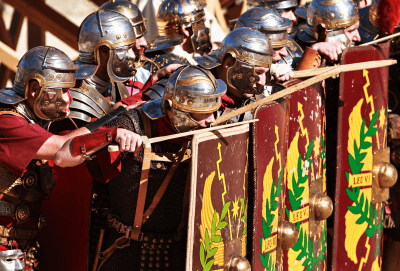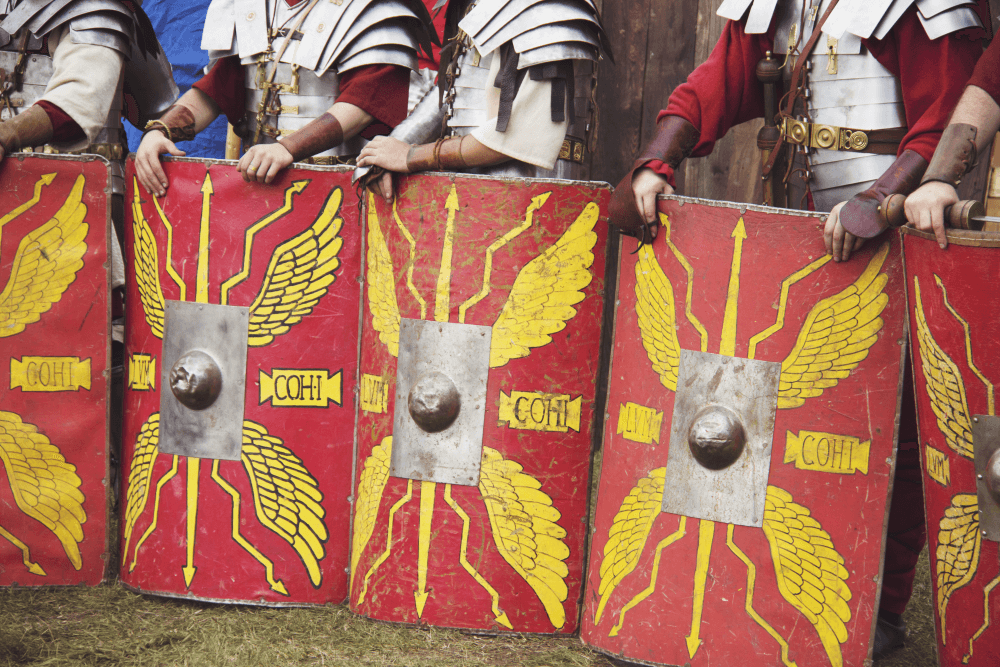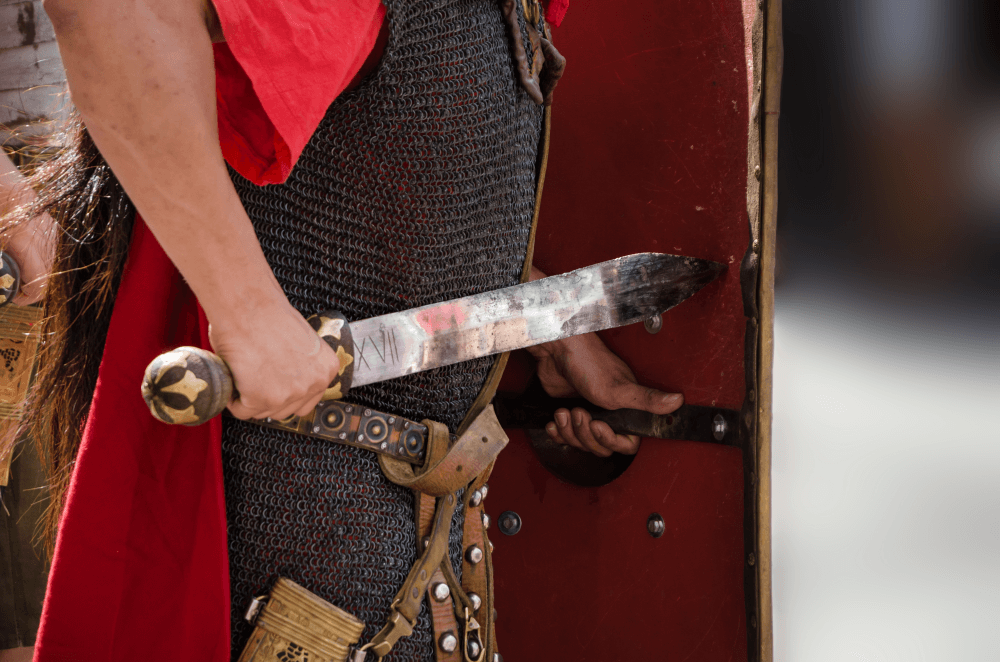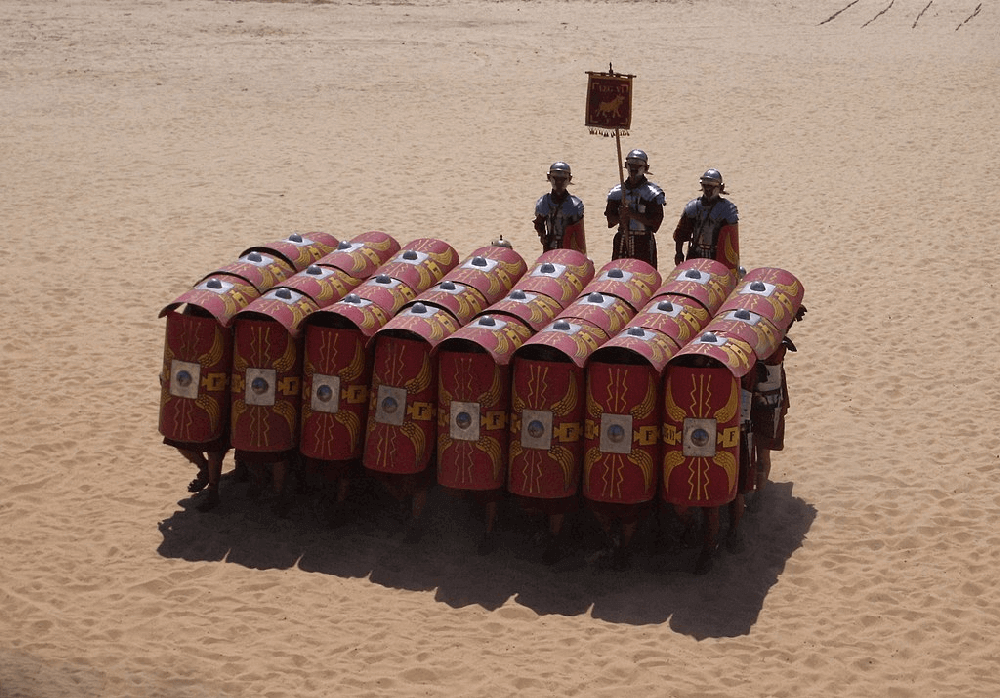The Iconic Roman Shield

The scutum, from the Latin term for "shield" was the iconic large Roman shield held by the soldiers in a Roman legion.
While oval and circular shields were used in the Roman military by different members of the armed forces and at varying times during the entire period of ancient Rome, the curved, rectangular scutum was the primary protective shield used by the legionaries during the height of Rome's military dominance in the Mediterranean region and the provinces beyond.
What did a Scutum Look Like?

A scutum was typically red in color, as red was the color of the Roman god of war, Mars. It was decorated with an iconic image such as a winged eagle to represent victory and lightning bolts, the scuta (plural for scutum) provided essential protection and were a vital reason for the military successes of ancient Rome.
The Roman writer Vegetius added that scuta helped in visual identification on the battlefield... presumably both during battle and identifying fallen soldiers afterwards:
Lest the soldiers in the confusion of battle should be separated from their comrades, every cohort had its shields painted in a manner peculiar to itself. The name of each soldier was also written on his shield, together with the number of the cohort and century to which he belonged.
_Vegetius, De Re Militari
Origin and Development of the Scutum
Much of Roman culture, religious beliefs and military techniques were influenced by, and based on, surrounding civilizations, especially during the early period of Roman history from its founding and as a fledgling city-state.
The scutum shield is no different, and was based initially on the smaller oval shields used by the Etruscans and ancient Greek phalanxes armed with spears. The small shields were highly manoeuvrable, but their diminutive size meant that parts of the body were exposed when fighting in a tight formation.
During the early part of the fourth century BC, the Romans changed their military tactics from the hoplite phalanx to the manipular formation. The manipular legion was organized into four lines, starting at the front: the velites; the hastati; the principes; and the triarii, and was much more flexible than the typically eight-line deep formation of a phalanx.
Not only did this fighting formation require a tremendous amount of discipline amongst the individuals of the legion in order to function effectively, but it also necessitated the change to larger, rectangular shields which could protect more of the body.
Why was a Scutum Curved?
The new scuta shields were curved for two reasons.
The first is that the curved design, combined with the umbo (shield boss; the little circular piece in the center of the shield), helped to deflect blows much more effectively. Unlike a flat surface which would take the full force of an enemy blow, a curved surface would make the weapon 'slip' off to the side and result in far less of an impact to the Roman soldier.
The second reason is that the slightly curved edges could overlap with the shields of the legionaries on either side. This provided almost complete protection against enemy blows for those on the front line, and this style of fighting in formation in close quarter combat, using the gladius sword to thrust forward, become the classic fighting style for legionaries of the later Republican period and for most of the Imperial period.
One of the best ancient descriptions of a scutum shield comes from the Greek historian Polybius, who said of an early second-century BC scutum:
The Roman panoply consists firstly of a shield (scutum), the convex surface of which measures two and a half feet in width and four feet in length, the thickness at the rim being a palm's breadth. It is made of two planks glued together, the outer surface being then covered first with canvas and then with calfskin. Its upper and lower rims are strengthened by an iron edging that protects it from descending blows and from injury when rested on the ground. It also has an iron shield boss (umbo) fixed to it which turns aside the most formidable blows of stones, pikes, and heavy missiles in general.
_Polybius
How Heavy was a Roman Scutum Shield?
Of course, one of the major downsides of having a larger shield is that it weighs much more and is less mobile. It is estimated that a scutum shield could have weighed as much as 10kg (22lb).
However, the creation of the scutum in response to the new fighting style meant that it didn’t need to be wielded around and moved very much in battle, so its weight was largely irrelevant.
What Size was a Scutum?
The only known surviving example of a Roman scutum shield is one dating from the mid third century AD, which is on display at Yale University Art Gallery (Link: https://artgallery.yale.edu/collections/objects/5959). It was discovered during excavations of the ancient city of Dura-Europos in Syria and measures 105.5cm tall × 41cm wide. It has an average thickness of 5-6cm.
What Was a Scutum Made From?

A typical scutum shield was made from three sheets of wood glued together and covered with canvas and leather. Later versions also had metal edges to improve the protection and make the scutum less likely to splinter and break from an enemy blow to the edge.
Scuta also featured an umbo (shield boss) in the center, which was the round raised part. This was usually made from iron. Not only did it help to deflect blown from an enemy’s weapon, it could also come in handy if there was a need to use the shield itself as a battering weapon at close quarters.
The umbo also provided space at the back for the soldier’s hand and knuckles as they gripped the shield, as can be seen in the image above.
It has been claimed that sometimes a Roman legionary would dip his shield in water before a battle if they were likely to encounter flaming arrows, but this is strongly debated. Soaking wooden shields in water would have made them extremely heavy, and whilst we said earlier that their weight was somewhat irrelevant in battle in terms of mobility, they did still need to be manoeuvred and carried.
Although the shields were made from flammable wood, flaming arrows would not have caused it to instantly burst into flames or anything like that, so taking this with the disadvantage of a large and cumbersome water-soaked piece of wood meant that a typical Roman legionary would have probably taken their chance with being able to pull out or extinguish a burning arrow that embedded itself in his shield, rather than pre-soaking it in water first.
The Famous Defensive Formation – The Testudo (Latin for "Tortoise")
 Neil Carey https://www.flickr.com/photos/ncarey/ / CC BY-SA
Neil Carey https://www.flickr.com/photos/ncarey/ / CC BY-SA
A Roman defensive formation which was has remained in popular interest ever since it was used in ancient times is the testudo. Testudo is the Latin word for tortoise, and is an apt name for this formation, where the shields of the men behind the front line place them over their heads.
Looking like a tortoise which has moved its head and limbs into its shell for complete protection, this defensive formation was used - and was highly effective - to protect against incoming enemy projectiles falling from above such as arrows, spears, or objects thrown by defenders atop of walls.
In fact, the Roman writer Cassius Dio claimed that the testudo formation was so strong that not only could a man walk across it, but even a horse and chariot could be ridden over the shields on the top.
Why Did the Scutum Fall out of Use?
Despite its overwhelming importance and a primary reason for the success of the Roman army over a number of centuries, the large scutum shield did not survive the entirety of the Roman period.
As always, there are be a number of reasons and contributory factors, but mainly the fall in use of the scutum can be linked to the decline of the Roman empire in general.
By the third century AD, the once strong and mighty empire, exemplified by its powerful and disciplined army, was starting to crumble. For one thing, large scutum shields manufactured from layers of wood with metal edges and central boss pieces were expensive to make, and the empire simply started to run out of money to produce them at scale. This meant that smaller and cheaper shields started to become the norm.
Secondly, the effectiveness of a scutum shield depends heavily on the discipline and training not only of an individual soldier, but of all of his comrades next to and around him. Any gaps between the shields in a tight defensive line can let in a strike from an enemy’s weapon, which, if causing serious injury or death and a person to fall, will create a bigger gap, and so on until the whole fighting unit is fatally compromised.
As the later Roman empire began to rely more and more on auxiliary troops from distant provinces, who were often inherently less devoted and less motivated to fight for Rome, morale and discipline began to suffer.
As time went on and the decline got worse, soldiers were rushed to plug gaps and quell uprisings without the same level of comprehensive training that legionaries received during the peak of Rome’s powers.
Quite often, later Roman soldiers fought more in their own style during a battle than “the Roman way,” according to the traditions and ways of where they grew up. It has been stated that a later Roman legionary looked more like a barbarian Germanic warrior than a Roman soldier.
Ironically, this moved shield design back to the smaller and lighter shields, similar to those of old, that could be wielded more easily in individual, hand-to-hand combat where it was now starting to become more about every man for himself rather than working as a collective unit in tight formation.
Thirdly, weapons themselves changed, which facilitated a change in the design for shields. In the case of the Romans, this was not so much changes to shields in response to the weapons they were facing from their enemies, but rather as a result of a change to the primary weapon they used.
During the later part of the Roman empire, the short gladius sword began to be replaced as the primary weapon by the spatha, which was a much longer sword of between 0.5 and 1m in length.
It was preferred, especially by those in the front line, as it gave a soldier a much greater reach when thrusting, meaning that the enemy did not need to get as close (and potentially do damage) before the sword could be used on him.
Wielding this longer, heavier sword required the soldier’s arm to move more, something which was hampered by the large scutum shield. Consequently, there was a need for smaller shields which did not cover so much of the body.
These spatha swords and smaller shields would eventually develop into the longswords and shields used by medieval knights centuries later during the Middle Ages.
Recommended Book:
Related Page:
Discussion Forum - Related Threads
- Changes in the scutum
- Roman shield handles, were they as awkward as in replicas?
- Was the stereotypical gladius completely useless without the stereotypical scutum or some other rectangular shield?
- Swords and shields




Legions of Rome: The Definitive History of Every Imperial Roman Legion
by Stephen Dando-Collins
Featuring more than 150 maps, photographs, diagrams and battle plans, Legions of Rome is an essential read for ancient history enthusiasts, military history experts and general readers alike.